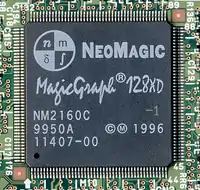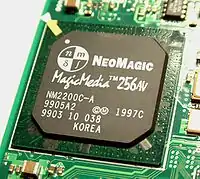NeoMagic
NeoMagic Corporation is a fabless semiconductor company and supplier of low-power audio and video integrated circuits for mobile use (MagicMedia).
 | |
| Type | Manufacturing, e-Commerce |
|---|---|
| OTC Pink: NMGC | |
| Founded | 1993 |
| Headquarters | San Jose, California |
| Products | SOCs |
| Website | www |
In October 2012, NeoMagic entered into the e-commerce arena with the acquisition of its MercadoMagico.com division. MercadoMagico.com provides a multivendor platform where users buy and sell products from one another or buy electronic products directly.
History
NeoMagic Corporation was founded in 1993 in California.[1] Working with semiconductor vendor Mitsubishi Electric as a key foundry supplier, NeoMagic introduced its first graphics processors in 1995;[2] these were notable for being the first chips to combine a graphics logic and DRAM video memory into one chip.[3] As this was a more power-efficient method than ones previously used by graphics processors, most of the major laptop manufacturers of the time began to use NeoMagic graphics chips in their systems.[2] In 2000, NeoMagic left the laptop market completely,[4] and switched their focus to producing systems on a chip, or SOCs, for mobile phones and other handheld devices, like PDAs.[5] The firm's first handheld chips were unveiled in 2001, when NeoMagic introduced the MiMagic line.[6] The initial MiMagic chips were based on a 32-bit MIPS Technologies RISC processor core, and featured 4MB of embedded DRAM, as well as a 1024x768-capable graphics chip, and an AC'97-compatible sound processor.[6] Subsequent versions of the MiMagic chip family starting from the MiMagic 3 in 2002, were based on 32-bit ARM RISC processor cores.[7] In October 2012, NeoMagic acquired MercadoMagico.com.[8]
MagicGraph

NM2160C

NM2200C-A
| Model | Chipset |
|---|---|
| MagicGraph 128 | NM2070 |
| MagicGraph 128V | NM2090 |
| MagicGraph 128ZV | NM2093 |
| MagicGraph 128ZV+ | NM2097 |
| MagicGraph 128XD | NM2160 |
| MagicMedia 256AV | NM2200 |
| MagicMedia 256AV+ | NM2230 |
| MagicMedia 256ZX | NM2360 |
| MagicMedia 256XL+ | NM2380 |
Adoption
These chips were used in a number of different laptop computers.[9] In 1998, Red Hat was able to release the source code of the XFree86 driver developed by Precision Insight Inc. which was previously distributed as proprietary software.[10] The NeoMagic driver included in the Linux kernel is partly based on the XFree86 one.[11]
References
- "Chip Maker NeoMagic Plans IPO". Los Angeles Times. 1997-01-22. Retrieved 2022-10-20.
- Pitta, Julie (July 1, 1998). "Reboot NeoMagic". Forbes. Retrieved January 18, 2015.
- Malik, O.P. (June 24, 1997). "NeoMagic on the rise". Forbes. Retrieved January 18, 2015.
- Hachman, Mark (April 21, 2000). "NeoMagic to exit PC graphics mkt. for wireless". EETimes. Retrieved January 18, 2015.
- Blickenstorfer, Conrad H. "Magic? No, NeoMagic". Pen Computing Magazine. Retrieved January 18, 2015.
- "NeoMagic hopes to weave new magic with RISC-based chips for handhelds". EETimes. July 10, 2001. Retrieved January 18, 2015.
- "Smallest SoC suits multimedia handhelds". Electronic Products. 2002-10-01. Retrieved 2019-06-13.
- "About Us". NeoMagic Corporation. Retrieved 18 January 2015.
- "xorg / driver / xf86-video-neomagic". GitLab. Retrieved 2020-03-03.
- "Neomagic driver source code released to Xfree86". www.redhat.com. Retrieved 2020-03-03.
- "torvalds/linux". GitHub. Retrieved 2020-03-03.
MercadoMagico.com http://www.themiddlemarket.com/news/neomagic-acquires-mercadomagico-com-234059-1.html
http://online.wsj.com/article/HUG1685831.html?mod=wsj_share_twitter
https://www.bloomberg.com/article/2013-05-07/atVaCKn_sLIc.html https://www.bloomberg.com/article/2013-05-28/aG8jWqLGA5cU.html